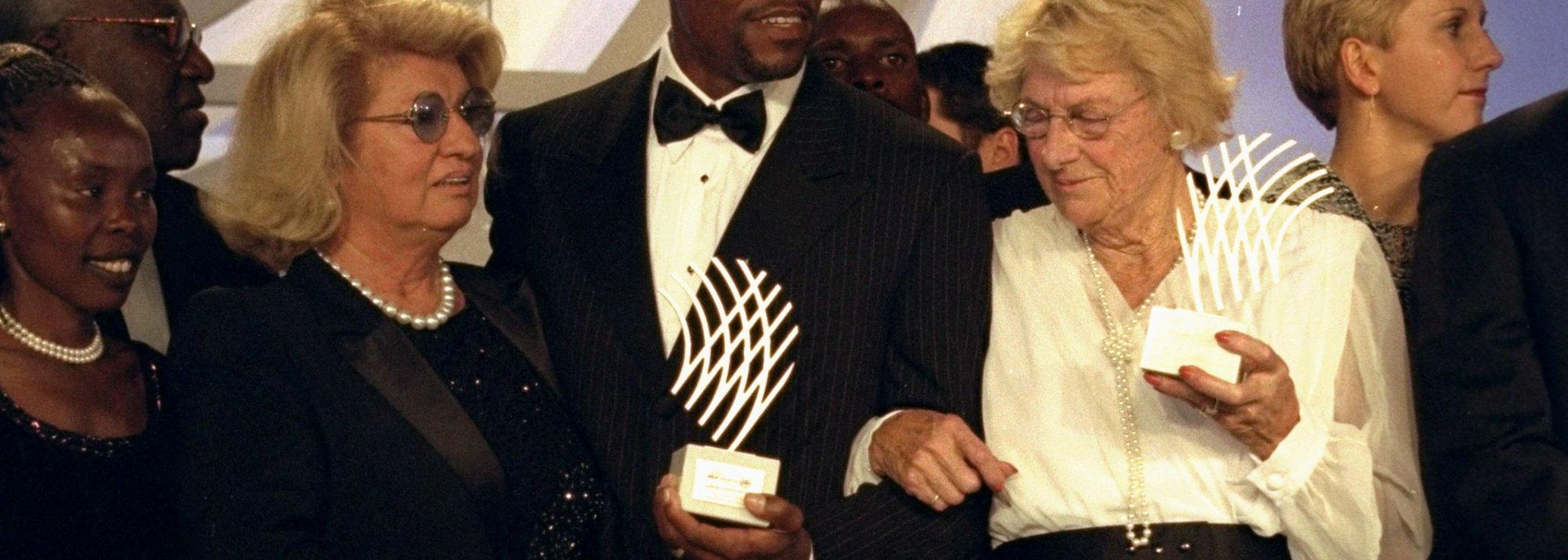21 Nov 1999: Giovanna Nebiolo, with Athletes of the Century Carl Lewis and Fanny Blankers-Koen at the IAAF Gala in the Salle D''Or of the Grand Hotel in Monte Carlo, Monaco. (© Getty Images)
By the late 1800s, popular enthusiasm for all types of physical exercise had caused a boom in participation sports. Athletics was especially popular, and soon became central to the exercise components of national educational systems. Organised athletics thrived in well developed industrial societies and an ever expanding competition programme developed in the schools and universities, in military organisations and private clubs.
The International Amateur Athletic Federation was founded in 1912 by 17 national athletic federations who saw the need for a governing authority, for an athletic programme, for standardised technical equipment and world records.
But what was the sport the IAAF was meant to govern? For participants, athletics was about enhancing the quality of life; it was something done for love and other noble principles. This permitted a limited group of athletes to achieve high-level performances by virtue of a privileged social and financial situation.
Yet with the continual evolution of modern society came tremendous enthusiasm for sport. This growing interest and the improvement of individual performances boosted the stature of athletics. Beginning in the 1960s, TV coverage of athletics greatly increased and many companies began to see commercial value in the sport. It became harder to follow the amateur principle in the traditional sense, especially considering the time and resources needed to train and maintain elite athletes. Faced with this commercially demanding world, the IAAF made changes to benefit the athlete, spectators and all other members of the "Athletics Family".
In 1982, the IAAF abandoned the traditional concept of amateurism and in 1985 created trust funds for athletes. The way to high performance was opened to larger groups of extremely talented athletes. Steadily, there has been a change from the so-called amateurs to financially motivated and secure athletes at the highest levels and this development has continued with the introduction of the IAAF Competition Awards in 1997, which offered prize money to successful athletes for the first time in the history of IAAF competitions. The development of applied sports sciences, improved equipment and new training and competition techniques, brought even more changes to the sport. Sadly, performance enhancing drugs became more prominent at this time as well, jeopardising the moral fabric of sport as well as the health and lives of young people.
The IAAF has subsequently led the sports movement worldwide in the development and application of an extensive anti-doping programme involving testing both in and out of competition.
Until the late seventies, athletics had its moment of glory every 4 years, at the Olympic Games. Today, The official IAAF Competition Programme now includes World Championships, World Junior Championships, World Youth Championships, World Indoor Championships, Continental Cup, World Cross Country Championships, World Race Walking Cup, World Half Marathon Championships, the international Diamond League and World Challenge series, Combined Events Challenge, Race Walking Challenge, Hammer Throw Challenge, Road Race Labels, and Permit circuits for indoor and cross country competitions. In addition a variety of major competitions at continental level reflect the expansion of the IAAF programme. Fourteen multi-sport and Area Games competitions, including the Olympic Games, are organised on all continents with athletics as the core sport. Added to this are thousands of other national and local area events. In 2003 the IAAF Congress approved the addition of Mountain Running to the list of disciplines governed by the IAAF. Mountain Running has its own World Championships and Grand Prix circuit.
With regard to administration, the number of affiliated federations grew dramatically, from 17 in 1912 to 213 in 2008, and back to 212 in 2010 when the Netherlands Antilles federation ceased to exist independently. All federations are invited to attend the IAAF Congress every two years with elections held during even-numbered Congresses. While once functioning in a way which favoured the wealthier, developed nations through its voting system, the IAAF adopted the ultimate democratic system of "one country, one vote" in 1987.
The IAAF Council, which administers all IAAF affairs, consisted of seven members drawn from 17 Member Federations in 1912, and this has grown to 27 from 212 today. In 1968, a representative of each area in the world was elected to the IAAF Council and in 1995 two women were elected for the first time. The IAAF now has six Area Group Associations. Council is assisted by six Committees and eight Commissions in the wide ranging decisions it must make. These are manned by experts in the various fields.
The IAAF Headquarters, which was initially the study of the General Secretary, now consists of three fine buildings in Monaco. The organisation now employs around seventy full-time multi-national professional staff.
This expansion and growth have only been possible due to a professionally planned marketing programme. The IAAF has long accepted the need to embrace corporate sponsorship as a means to better promote and develop the sport world wide. In the early days IAAF income was restricted to membership fees paid by the affiliated member federations and additional sums from the selling of the IAAF publications. But in recent years, with the expansion of the competition programme and the huge interest in athletics shown by TV and corporate partners, this income has increased dramatically.
This move towards a more professional sport was particularly recognised in 2001, when the IAAF Congress voted unanimously for the organisation's name to be changed to the International Association of Athletics Federations.
IAAF



